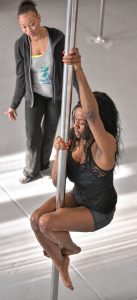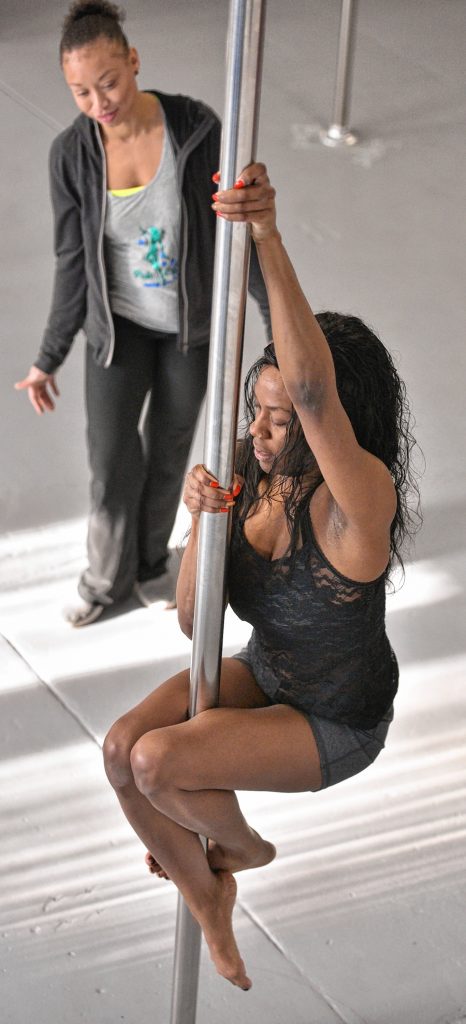
Ashley Robertson, of Springfield, practices pole dancing as Holly Wood coaches her at Pole Control Studios, Saturday, Jan. 27, 2018 in Springfield.
Holly Woods has always loved the art of dance. When she was a young girl in Manhattan, her mother rented an apartment above Alvin Ailey’s studio. “I would go downstairs and hangout and watch the ballet dancers perform,” she recalls. “You would see Debbie Allen and all these people coming and going. It was like Fame; I was fascinated by it.” When her family later moved to Apalachicola, Florida, she did the same thing at the town ballet school. Watching quietly from the outside and taking in all that she could.
Without formal training, Woods circumvented the mainstream and became a pole dancer in the adult entertainment industry.
In January, she hung out her shingle in Springfield after closing her studio in Hartford. Tucked in at 78 Hillman Street in downtown’s Apremont Triangle, Pole Control Studios Academy Aerial Arts of New England is open for business.
Woods has often found herself a part of a conversation seeking to parse the difference between pole dancing and pole fitness. A conversation recently highlighted when it was announced that the Global Association of International Sports Federations has determined pole dancing a provisional Olympic sport under observer status — the first step toward joining the Olympic program. In an attempt to reflect the interests of younger generations, pole dancing will, under the leadership if the International Pole Sports Federation, seek entry into the pantheon of the world’s most prestigious athletic competitions. Before they do, however, they must clear several hurdles, including growing support amongst its practitioners.
Growing a base of support may be the easiest hurdle for pole fitness. For more than a decade, the International Pole Sports Federation has been looking for an image overhaul, a re-branding of sorts, and there has been a growing movement to return pole dancing to its purely athletic roots. Building on a rich history of Asian competitive pole acrobatics, the federation has worked diligently to change perceptions and to promote pole fitness as a non-sexual sport. Their ultimate goal is to get pole dancing entry into the Olympics under the sanitized nomenclature pole fitness or vertical dance.
But as the federation seeks to change perceptions, no one is deluding themselves into thinking exotic pole dancing will lose its audience. So a studio like Pole Control inherently finds itself choosing between selling sex or sport — or both. When asked how important is it that pole fitness distance itself from pole dancing to be given athletic and competitive legitimacy, Woods replies, “I’ve often repeated at symposiums with other pole dance business owners, the goal towards Olympic competition can be a detriment to our sport if the adult entertainment industry, as a taboo industry, is a constant reminder of where the general public thinks we belong. Pole fitness is the core exercise program for pole dancing so they are highly symbiotic . . . .”
Woods has been a pole dancer for 20 years, which is hard to believe since she doesn’t look a day over 25. A bright cheerful woman, tiny in stature but big on warmth, Woods says she opened her studio purely out of a love for pole dancing. In the late ‘90s she was featured in a series of successful underground pole dance films. Because the adult entertainment industry had no links to the fitness industry, Woods had to showcase the films at Adult Video News conventions. They became so popular, they led to an instruction-based web series that caught on in the mainstream. Woods says, “Since then it’s been nothing but professionals, students, and domestic dons and divas” taking lessons at her studio. “I created a pole fitness program to prepare students for pole dancing,” she states. “And we take the art of pole fitness very seriously.” But Woods says, she knows the knocks her studio will take given the sexualized nature of the activity. She, however, believes all female athletes are unnecessarily sexualized and the American misogynistic mindset will never allow pole fitness to completely differentiate itself from pole dancing.
Moreover, Woods finds that some of the biggest misogynist culprits are women. “When I’m at expos,” Woods says, “oftentimes women will pass by and say something like, ‘They’ll say anything is a workout. What are they going to do next, humping classes?’” Her response is usually to engage them and to challenge them. “I ask them if they’ll let me show them one thing on the pole. If they try it and if they can do it, I’ll give them a class for free. They’ll try a move or take a class and discover that [pole fitness] is very hard. I believe the teaching aspect helps women get out of the frame of mind that pole dancing is not a fitness routine. The class curriculum can be strenuous to someone undisciplined, and it will change the way you see adult entertainment.”
Pole fitness will not receive its full membership as an Olympic sport for some time; it will not be part of the 2020 Olympic Games in Tokyo. Every provisional sport has to receive recognitions by National Olympic Committees and become compliant with World Doping Agency regulations. It also needs to be practiced by women in 40 countries on three continents and by men in 75 countries on four continents. In the meantime, competitions around the world for pole dancing and pole fitness will continue to thrive, producing athletes who may one day garner medals on the sports world’s biggest stage.
Gina Beavers can be reached at gbeavers@valleyadvocate.com.



